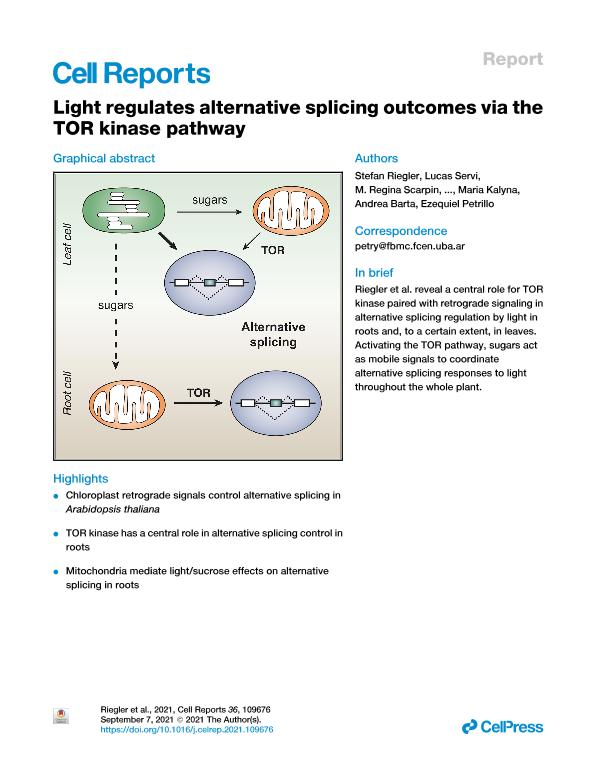Artículo
Light regulates alternative splicing outcomes via the TOR kinase pathway
Riegler, Stefan; Servi, Lucas ; Scarpin, Maria Regina
; Scarpin, Maria Regina ; Godoy Herz, Micaela Amalia
; Godoy Herz, Micaela Amalia ; Kubaczka Zoppi, María Guillermina Jazmín
; Kubaczka Zoppi, María Guillermina Jazmín ; Venhuizen, Peter; Meyer, Christian; Brunkard, Jacob O.; Kalyna, Maria; Barta, Andrea; Petrillo, Ezequiel
; Venhuizen, Peter; Meyer, Christian; Brunkard, Jacob O.; Kalyna, Maria; Barta, Andrea; Petrillo, Ezequiel
 ; Scarpin, Maria Regina
; Scarpin, Maria Regina ; Godoy Herz, Micaela Amalia
; Godoy Herz, Micaela Amalia ; Kubaczka Zoppi, María Guillermina Jazmín
; Kubaczka Zoppi, María Guillermina Jazmín ; Venhuizen, Peter; Meyer, Christian; Brunkard, Jacob O.; Kalyna, Maria; Barta, Andrea; Petrillo, Ezequiel
; Venhuizen, Peter; Meyer, Christian; Brunkard, Jacob O.; Kalyna, Maria; Barta, Andrea; Petrillo, Ezequiel
Fecha de publicación:
09/2021
Editorial:
Elsevier
Revista:
Cell Reports
ISSN:
2211-1247
Idioma:
Inglés
Tipo de recurso:
Artículo publicado
Clasificación temática:
Resumen
For plants, light is the source of energy and the most relevant regulator of growth and adaptations to the environment by inducing changes in gene expression at various levels, including alternative splicing. Light-triggered chloroplast retrograde signals control alternative splicing in Arabidopsis thaliana. Here, we provide evidence that light regulates the expression of a core set of splicing-related factors in roots. Alternative splicing responses in roots are not directly caused by light but are instead most likely triggered by photosynthesized sugars. The target of rapamycin (TOR) kinase plays a key role in this shoot-to-root signaling pathway. Knocking down TOR expression or pharmacologically inhibiting TOR activity disrupts the alternative splicing responses to light and exogenous sugars in roots. Consistently, splicing decisions are modulated by mitochondrial activity in roots. In conclusion, by activating the TOR pathway, sugars act as mobile signals to coordinate alternative splicing responses to light throughout the whole plant.
Archivos asociados
Licencia
Identificadores
Colecciones
Articulos(IFIBYNE)
Articulos de INST.DE FISIOL., BIOL.MOLECULAR Y NEUROCIENCIAS
Articulos de INST.DE FISIOL., BIOL.MOLECULAR Y NEUROCIENCIAS
Citación
Riegler, Stefan; Servi, Lucas; Scarpin, Maria Regina; Godoy Herz, Micaela Amalia; Kubaczka Zoppi, María Guillermina Jazmín; et al.; Light regulates alternative splicing outcomes via the TOR kinase pathway; Elsevier; Cell Reports; 36; 10; 9-2021; 1-22
Compartir
Altmétricas



